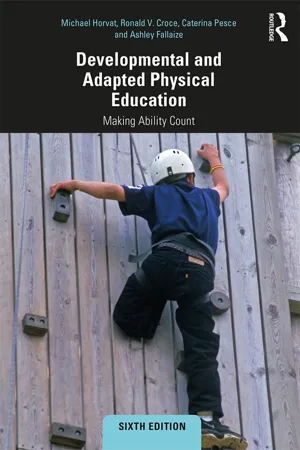
Developmental and Adapted Physical Education
Making Ability Count
- 504 pages
- English
- ePUB (mobile friendly)
- Available on iOS & Android
Developmental and Adapted Physical Education
Making Ability Count
About this book
Now in a fully revised and updated 6th edition, reflecting changes in legislation and cutting-edge research, this is a complete introduction to adapted physical education, from the underpinning science to practical teaching strategies and program design.
The book covers a broader range of disabilities, developmental disorders, and health conditions than any other textbook and includes brand new material on developmental coordination disorders and cognitive development. Full of teaching and coaching strategies and techniques, it introduces scientific fundamentals, key legislation, and best practice in designing effective programs. It encourages the reader to consider the individual before the disability and to focus on what learners can do rather than what they can't.
This is an essential reference for teachers, coaches, or exercise professionals working with children with disabilities. It is also an invaluable resource for undergraduate or postgraduate students of adapted physical education, kinesiology, physical education, physical therapy, exercise science, athletic training, or sports coaching.
The new edition features updated online resources, including PowerPoint slides, web links, an example syllabus, and quizzes.
Frequently asked questions
- Essential is ideal for learners and professionals who enjoy exploring a wide range of subjects. Access the Essential Library with 800,000+ trusted titles and best-sellers across business, personal growth, and the humanities. Includes unlimited reading time and Standard Read Aloud voice.
- Complete: Perfect for advanced learners and researchers needing full, unrestricted access. Unlock 1.4M+ books across hundreds of subjects, including academic and specialized titles. The Complete Plan also includes advanced features like Premium Read Aloud and Research Assistant.
Please note we cannot support devices running on iOS 13 and Android 7 or earlier. Learn more about using the app.
Information
Section I
Introduction
Physical education for children with disabilities
- the availability of physical education services at the federal, state, and local levels;
- an understanding of individualized education plans (IEP) that are developed to place children with disabilities in the least restrictive learning environment based on the needs of the child;
- an understanding of the roles of parents and various administrative professionals in the educational process and input on the MPT;
- a determination of how the child’s need are met through evaluation and assessment in program planning and implementation; and
- the application of the developmental concepts of physical fitness, movement development, motor skill acquisition, and cognitive and perceptual development when teaching children with disabilities.
1 But first I have some questions, professor
Case Study
- How will I know whether a condition qualifies as a disability and who makes that decision?
- Is physical education really required for ALL children and ALL types of disabilities?
- Who decides whether a child with a disability will be in physical education classes? (The class was especially interested in this question.)
- How will I determine the needs of children with disabilities?
- Who decides whether a child with a disability will be in my physical education class?
Causes of disability
Needs of children with disabilities in physical education
Learning activity
Chapter summary
- 1 Questions that appear in this chapter are representative of those asked in the authors’ classes by students who are new to adapted physical education. They are real questions from real people. More questions will arise as the term progresses, and you are encouraged to ask. Know that your questions can contribute positively to class dynamics. Classes tend to be most satisfying, from both the students’ and teacher’s perspective, when students proactively take part in the learning process.
- 2 Many people, including some students and their teachers, unwittingly perpetuate disability labels and stereotypes about people who have disabilities and, in so doing, deny persons with disability dignity, individuality, and opportunity to achieve in accordance to potential.
- 3 Physical education teachers, regular and adapted, must become familiar with the origin, duration, and severity range of many disabling conditions, but even more important, physical educators must learn to look beyond the disability so as to develop meaningful learning experiences designed to maximize each individual’s unique potential.
- 4 Quite generally, children with and without disabilities are more alike than different. Recognizing this reality can become an important part of the rationale to include, whenever reasonably possible, children with disabilities in regular education settings.
- 5 A major trend over the past three decades has been to include more children with disabilities in regular education settings. There are at least two explanations for this, one negative and one positive. Negative: increasingly tight budgets, particularly during tight economic times, mitigate against placing children with disabilities, when educationally necessary, in relatively more restrictive educational settings. Positive: progress with regard to teacher preparation, both pre-service and in-service, enables teachers today, perhaps more than ever before, to meaningfully integrate children with disabilities into regular classroom settings.
- 6 IDEA (2004) was last revised in 2004 and first appeared in 1975 (Education for All Handicapped Children Act of 1975). Of particular significance to physical educators is that physical education is explicitly mentioned by name in the law’s definition of special education. Physical education, by virtue of its explicit inclusion in the definition, is integral to special education, and, therefore, must be made available to children with disabilities, wherever such opportunities are available to children without disabilities.
References
2 Legal mandates
Case Study
Table of contents
- Cover
- Half Title
- Title
- Copyright
- Dedication
- Contents
- Section I Introduction: physical education for children with disabilities
- Section II Teaching individuals with learning and behavior disabilities
- Section III Teaching individuals with sensory impairments
- Section IV Teaching individuals with congenital and acquired impairments
- Section V Teaching individuals with health impairments
- Section VI Developing and implementing the physical activity program
- Index